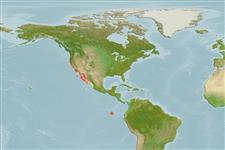Lớp phụ Cá sụn (cá mập và cá đuối) (sharks and rays) >
Myliobatiformes (Stingrays) >
Myliobatidae (Eagle and manta rays)
Etymology: Myliobatis: Greek, mylo = mill + Greek, + Greek, batis,-idos = a ray (Raja sp.) (Ref. 45335).
More on author: Gill.
Environment: milieu / climate zone / depth range / distribution range
Sinh thái học
Biển gần đáy; Mức độ sâu 0 - 108 m (Ref. 96339). Subtropical; 43°N - 5°S, 126°W - 85°W (Ref. 55258)
Eastern Pacific: Oregon, USA to Gulf of California (Ref. 2850) and the Galapagos Islands (Ref. 28023).
Bộ gần gũi / Khối lượng (Trọng lượng) / Age
Maturity: Lm ? range ? - ? cm
Max length : 180 cm WD con đực/không giới tính; (Ref. 2850); common length : 100.0 cm WD con đực/không giới tính; (Ref. 9257); Khối lượng cực đại được công bố: 82.1 kg (Ref. 40637)
Commonly found in sandy and muddy bays and sloughs, also on rocky bottom and in kelp beds (Ref. 2850). Sometimes buries itself in sand (Ref. 2850). Found singly or in schools (Ref. 12951). Feeds on bivalves, snails, polychaetes, shrimps, and crabs (Ref. 9257). Ovoviviparous (Ref. 50449). Venomous spine on tail. Not fished commercially, but shows up as by-catch species (Ref. 9257).
Exhibit ovoviparity (aplacental viviparity), with embryos feeding initially on yolk, then receiving additional nourishment from the mother by indirect absorption of uterine fluid enriched with mucus, fat or protein through specialised structures (Ref. 50449).
McEachran, J.D. and G. Notarbartolo di Sciara, 1995. Myliobatidae. Aguilas marinas. p. 765-768. In W. Fischer, F. Krupp, W. Schneider, C. Sommer, K.E. Carpenter and V. Niem (eds.) Guia FAO para Identification de Especies para los Fines de la Pesca. Pacifico Centro-Oriental. 3 Vols. FAO, Rome. (Ref. 9257)
IUCN Red List Status (Ref. 130435: Version 2024-1)
Human uses
Các nghề cá: Tính thương mại; cá để chơi: đúng; Bể nuôi cá: Bể cá công cộng
Các công cụ
Special reports
Download XML
Các nguồn internet
Estimates based on models
Preferred temperature (Ref.
123201): 12.4 - 23, mean 20.6 °C (based on 34 cells).
Phylogenetic diversity index (Ref.
82804): PD
50 = 0.5002 [Uniqueness, from 0.5 = low to 2.0 = high].
Bayesian length-weight: a=0.00389 (0.00119 - 0.01269), b=3.08 (2.83 - 3.33), in cm total length, based on LWR estimates for this (Sub)family-body shape (Ref.
93245).
Mức dinh dưỡng (Ref.
69278): 3.2 ±0.1 se; based on diet studies.
Thích nghi nhanh (Ref.
120179): thấp, thời gian nhân đôi của chủng quần tối thiểu là 4.5 - 14 năm (tm=3; tmax=23; k=0.09-0.22).
Fishing Vulnerability (Ref.
59153): Very high vulnerability (75 of 100).
Nutrients (Ref.
124155): Calcium = 8.59 [1.10, 170.56] mg/100g; Iron = 0.647 [0.059, 7.948] mg/100g; Protein = 20.5 [15.2, 25.6] %; Omega3 = 0.159 [0.050, 0.437] g/100g; Selenium = 28.9 [5.9, 146.1] μg/100g; VitaminA = 3.22 [0.27, 34.64] μg/100g; Zinc = 0.476 [0.031, 5.520] mg/100g (wet weight);
